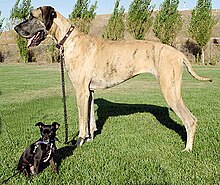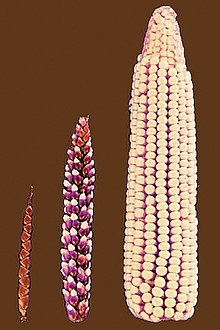This is an old revision of this page, as edited by 112.204.23.137 (talk) at 08:41, 27 February 2012 (→Laboratory usage). The present address (URL) is a permanent link to this revision, which may differ significantly from the current revision.
Revision as of 08:41, 27 February 2012 by 112.204.23.137 (talk) (→Laboratory usage)(diff) ← Previous revision | Latest revision (diff) | Newer revision → (diff) For alternate uses, see Selective breeding. "Unnatural selection" redirects here. For other uses, see Unnatural Selection (disambiguation).
| Part of a series on |
| Evolutionary biology |
|---|
 Darwin's finches by John Gould Darwin's finches by John Gould |
| Processes and outcomes |
| Natural history |
| History of evolutionary theory |
Fields and applications
|
| Social implications |

Artificial selection (or selective breeding) describes intentional breeding for certain traits, or combination of traits. The term was utilized by Charles Darwin in contrast to natural selection, in which the differential reproduction of organisms with certain traits is attributed to improved survival or reproductive ability (“Darwinian fitness”). As opposed to artificial selection, in which humans favor specific traits, in natural selection the environment acts as a sieve through which only certain variations can pass.
The deliberate exploitation of artificial selection has become very common in experimental biology, as well as the discovery and invention of new drugs. Artificial selection can also be unintentional; it is thought that domestication of crops by early humans was largely unintentional.
Historical development
Artificial selection was practiced by the Romans. Treatises as much as 2,000 years old give advice on selecting animals for different purposes, and these ancient works cite still older authorities, such as Mago the Carthaginian. The notion of artificial selection was later expressed by the Persian Muslim polymath Abu Rayhan Biruni in the 11th century. He noted the idea in his book titled India, and gave various examples.
The agriculturist selects his corn, letting grow as much as he requires, and tearing out the remainder. The forester leaves those branches which he perceives to be excellent, whilst he cuts away all others. The bees kill those of their kind who only eat, but do not work in their beehive.
Charles Darwin coined the term as an illustration of his proposed wider process of natural selection. Darwin noted that many domesticated animals and plants had special properties that were developed by intentional animal and plant breeding from individuals that showed desirable characteristics, and discouraging the breeding of individuals with less desirable characteristics.
Darwin used the term twice in the 1859 first edition of his work On the Origin of Species, in Chapter IV: Natural Selection, and in Chapter VI: Difficulties on Theory –
Slow though the process of selection may be, if feeble man can do much by his powers of artificial selection, I can see no limit to the amount of change, to the beauty and infinite complexity of the co-adaptations between all organic beings, one with another and with their physical conditions of life, which may be effected in the long course of time by nature's power of selection. We are profoundly ignorant of the causes producing slight and unimportant variations; and we are immediately made conscious of this by reflecting on the differences in the breeds of our domesticated animals in different countries,—more especially in the less civilized countries where there has been but little artificial selection.
Contrast to natural selection
There is no real difference in the genetic processes underlying artificial and natural selection, and the concept of artificial selection was used by Charles Darwin as an illustration of the wider process of natural selection. The selection process is termed "artificial" when human preferences or influences have a significant effect on the evolution of a particular population or species. Indeed, many evolutionary biologists view domestication as a type of natural selection and adaptive change that occurs as organisms are brought under the control of human beings.
However, it is useful to distinguish between artificial selection that is unintentional or involves manipulating the environment only, and artificial selection that alter internal DNA sequences in the laboratory. Genetic manipulation in labs has little in common with processes that occur in nature.
==Laboratory usage== The deliberate exploitation of selective power has become common in experimental biology, particularly in microbiology and genetics. In a ubiquitous laboratory technique in genetic engineering, genes are introduced into cells in cell culture, usually bacteria, on a small circular DNA molecule called a plasmid in a process called transfection. The gene of interest is accompanied on the plasmid by a reporter gene, or "selectable marker", which encodes a specific trait such as antibiotic resistance or ability to grow in high salt concentrations. The cells can then be cultured in an environment that would kill normal cells, but is hospitable to those that have taken up and expressed the genes on the plasmid. In this way expression of the reporter gene serves as a signal that the gene of interest is also being expressed in the cells.
Another technique used in drug development uses an iterative selective process called in vitro selection to evolve aptamers, or nucleic acid fragments capable of binding specific organic compounds with high binding affinity.
Studies in evolutionary physiology, behavioral genetics, and other areas of organismal biology have also made use of deliberate artificial selection, though longer generation times and greater difficulty in breeding can make such projects challenging in vertebrates.
See also
- Animal breeding
- Experimental evolution
- Gene pool
- Genetic engineering
- Genomics of domestication
- Inbreeding
- Marker assisted selection
- Plant breeding
- Quantitative genetics
- Selective breeding
- Selection methods in plant breeding based on mode of reproduction
- Smart breeding
References
- Artificial Selection PowerPoint, University of Wisconsin-Madison
- Buffum, Burt C. Arid Agriculture; A Hand-Book for the Western Farmer and Stockman, p. 232. Accessed at , June 20, 2010.
- Lush, Jay L. Animal Breeding Plans, p. 21. Accessed at , June 20, 2010.
- Jan Z. Wilczynski (December 1959), "On the Presumed Darwinism of Alberuni Eight Hundred Years before Darwin", Isis, 50 (4): 459–466
- Darwin 1859, p. harvnb error: no target: CITEREFDarwin1859 (help)
- Darwin 1859, pp. 197–198 harvnb error: no target: CITEREFDarwin1859 (help)
- Swallow JG, Garland T, Jr. (2005). Selection experiments as a tool in evolutionary and comparative physiology: insights into complex traits—an introduction to the symposium. Integr Comp Biol, 45:387–390.PDF
- Garland T, Jr. (2003). Selection experiments: an under-utilized tool in biomechanics and organismal biology. Ch.3, Vertebrate Biomechanics and Evolution ed. Bels VL, Gasc JP, Casinos A. PDF
- Garland T, Jr., Rose MR, eds. (2009). Experimental Evolution: Concepts, Methods, and Applications of Selection Experiments. University of California Press, Berkeley, California.